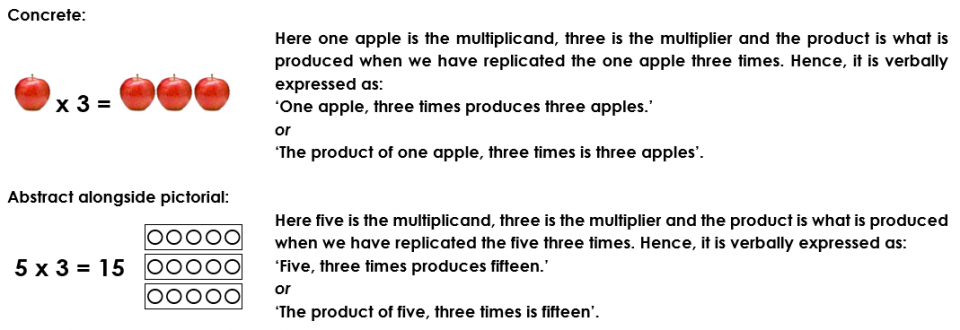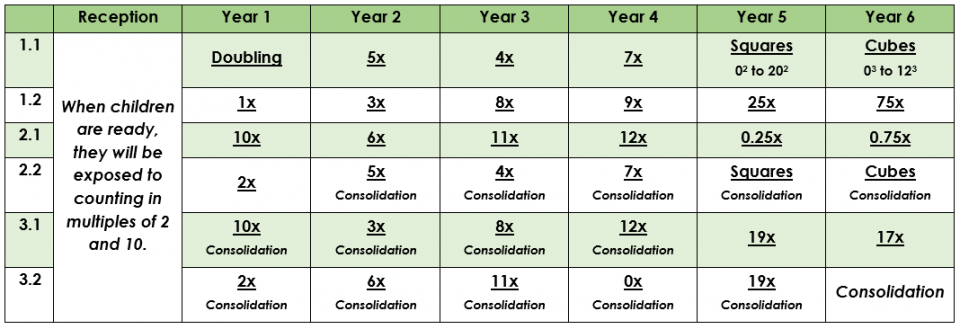Intent
At Hethersett Woodside we believe that it is important that children are given the opportunity to see, explore, and understand the mathematical structures and patterns of multiplication bonds (times tables) for real deep, embedded learning. We want our children to know their multiplication bonds really well and through developing a deep conceptual understanding alongside the ability to recall, they will be able to apply them confidently, including the inverses.
Multiplication bonds are fundamental to many maths topics (for example, fractions and algebra) and calculation strategies (for example, short multiplication, long multiplication, short division and long division), requiring children to be able to carry them out quickly and with a degree of automaticity. With nearly 60% of GCSE topics being traced to a root in multiplication bonds, we aim to provide solid foundations for their next stage of education. Being fluent in multiplication bonds means that working memory is freed up, which in turn reduces the cognitive load and leaves space to explore new mathematical ideas, reason and solve more complex problems.
Implementation
Use of Language
At Woodside we believe that deep understanding of a mathematical concept happens through a CPA approach. Therefore it is essential that we use the correct language when reading and writing multiplication calculations. Whilst there is not the expectation to use this with the children, the correct terminology is:
multiplicand x multiplier = product
As the multiplicand refers to a quantity which is multiplied by another, the multiplier, we teach multiplication as a quantity (the group size) and the number of times we need it. The below examples represent this:

Through the correct use of language, we are preparing our children for more abstract concepts. In particular, the links with algebra where children will be exposed to expressions like 6n, where 6 is the constant and n is the variable.
Progression of Teaching
The following table shows which multiplication bonds will be taught per half term. For each set of multiplication bonds (Years 1 to 4), children will learn the facts for the multipliers 0 to 12. In Years 5 and 6 children will learn the multiplication facts for the multipliers 0 to 10. This is because we aspire that as children develop fluency with multiplication they will be able to use the distribution law to work out further multipliers, for example 12 x 19 = (10 x 19) + (2 x 19).

Learning Sequence
Recognising the importance of children being able to efficiently calculate or retrieve their multiplication bonds, we know that children need a combination of direct teaching alongside regular and frequent practice. In each class, a whole half term is devoted to a new multiplication bond. Following a project carried out by the South East London Maths Hub, Jenny Field explained that the reason for focusing on one multiplication table per half term is due to neuro plasticity.
…the formation of a new neural pathway takes approximately eight-ten weeks. This time allows for the early formation of a myelin sheath around this pathway which contributes to automaticity – making it a ‘go to’ place for recall. Article for Reference
Within each half term, three lessons are devoted to exploring the new multiplication table – developing connections, exploring patterns and creating a deeper understanding of multiplicative reasoning with specific focus on the new multiplication bonds. As the new table is introduced, class teachers will systematically build it together with the children using the bonds that they already know and have met before. Teachers and children will also make clear conceptual links to the real world, creating a half termly display of ‘What comes in…’ that will be part of their Maths Working Wall. The first two lessons of direct teaching will be allocated at the start of each half term, and the final one will be placed later in the half term, at a time chosen by the class teacher.
Once the new multiplication table has been introduced for the half term, three or more times a week in every class there will be a five- to ten- minute ‘retrieval practice’ session. During these one or more activities will be used that include conceptual support; full verbal patterning (saying whole calculation) and also step counting, and learning the multiplication facts in order then out of order. Saying the full verbal pattern aloud supports the process of storing facts into our verbal memory. In the above article, Jenny Field stated ‘An emphasis on saying (and hearing) the sound pattern of the phrase is important and can lead to verbal prediction and patterning – however this practice can and should include conceptual support.’
For further information, please read our Multiplication Bonds Overview.

